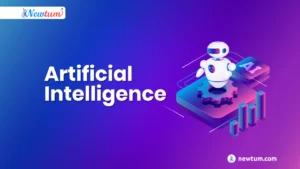Artificial Intelligence (AI) and Machine Learning (ML) are like two close cousins in the world of technology. People often mix them up, but it’s important to know that they are similar but not exactly the same. In this blog, we’ll explain the differences between AI and ML in simple terms, talk about what each of them can do, where they are used, and how they’re changing different industries.
What is Artificial Intelligence (AI)?
According to John McCarthy, a pioneer in Artificial Intelligence (AI), AI is the “science and engineering of making intelligent machines, especially intelligent computer programs.” In simpler terms, AI enables computers and software to think intelligently, similar to how humans do.
AI systems don’t require pre-programming; instead, they use algorithms to learn and make intelligent decisions on their own. You can find AI in applications like Siri, Google, AlphaGo, and even in chess-playing programs.
AI can be categorized into three types based on capabilities:
1. Weak AI
2. General AI
3. Strong AI (Future AI)
Currently, we work with weak AI and general AI, with strong AI being the potential future where AI systems are more intelligent than humans.
What Is Machine Learning (ML)?
Machine Learning (ML) is a subset of artificial intelligence (AI) that focuses on the development of algorithms and statistical models that enable computer systems to learn from and make predictions or decisions based on data. In essence, ML allows machines to automatically improve their performance on a specific task through experience, without being explicitly programmed to do so.
Machine Learning (ML) can be classified into several types or categories based on various criteria:
1. Supervised Learning
2. Unsupervised Learning
3. Semi-Supervised Learning
4. Reinforcement Learning
5. Deep Learning
6. Transfer Learning
7. Online Learning
8. Instance-Based Learning
How are AI and ML connected?
AI and ML are closely related but not identical. Think of AI as the overarching field in computer science that strives to create machines capable of tasks requiring human-like intelligence, like problem-solving, understanding language, and decision-making.
- Machine Learning is a branch of artificial intelligence. Its focus is on crafting algorithms and models that empower computers to learn and make predictions or decisions by processing data.
- In the broader AI landscape, ML is just one of the techniques or methods used to achieve the goal of creating intelligent systems. AI encompasses various other techniques, including rule-based systems, expert systems, and symbolic reasoning, in addition to ML.
Difference Between AI and ML
| Aspects | Artificial Intelligence | Machine Learning |
| Definition | AI aims to create machines that can think and learn like humans. | ML is a subset of AI that focuses on training machines to learn from data without being explicitly programmed. |
| Scope | Broader in scope, encompassing various techniques and technologies to create intelligent systems. | A specific subfield of AI that uses algorithms and models to enable machines to learn and make predictions based on data. |
| Goal | The goal of AI is to create intelligent machines capable of reasoning, problem-solving, understanding natural language, and more. | ML’s primary goal is to enable machines to learn from data and improve their performance on specific tasks. |
| Human-like Thinking | AI aims to mimic human cognitive functions and make machines think and behave like humans. | While ML does not necessarily aim to mimic human thinking, it focuses on pattern recognition and learning from data. |
| Examples of Techniques | Expert systems, symbolic reasoning, natural language processing, computer vision, and more. | Supervised learning, unsupervised learning, reinforcement learning, and other learning algorithms. |
| Data Dependency | AI applications may or may not heavily rely on large datasets, depending on the specific technique used. | ML heavily relies on data for training and improving model performance. |
| Range of Applications | AI has a wide range of applications, including virtual assistants, self-driving cars, and medical diagnosis. | ML is commonly used in recommendation systems, fraud detection, image recognition, and many more. |
| Flexibility | AI systems can incorporate various techniques, including ML, rule-based systems, and expert systems, for flexibility in problem-solving. | ML focuses on learning from data and is particularly well-suited for tasks with large datasets and complex patterns. |
| Adaptability | AI systems can be rule-based and static or adaptive, depending on the chosen techniques. | ML models are adaptive and can continuously improve their performance as they encounter more data. |
Advantages & Disadvantages of Artificial Intelligence
One of the major advantages of artificial intelligence is that its decisions are based on facts rather than emotions.
Advantages of Artificial Intelligence (AI)
The benefits of artificial intelligence are incredible, what this area can offer us, is to evolve definitively and move on to the history of artificial robots.
The following are the main advantages of Artificial Intelligence (AI).
- Finished task faster than a human,
- Stressful and complex work completed easily,
- The success ratio is high
- Less errors in tasks and defects
Disadvantages of Artificial Intelligence (AI)
Some of the main disadvantages of Artificial Intelligence (AI) in our daily lives are as follows.
- Sometimes it can be misused leading to mass-scale destruction
- Unemployment problem increased
- Creativity depends upon the programmer
- Lacks the human touch
- The younger generation becomes lazy
- Requires a lot of time and money, and technological dependency increased.
Advantages & Disadvantages of Machine Learning
Every coin has two faces, each face has its own property and features. It’s time to uncover the faces of ML. A very powerful tool that holds the potential to revolutionize the way things work.
Advantages of Machine Learning:
1. Trend Discovery: ML can spot trends and patterns in vast datasets, helping businesses like Amazon understand user behavior and offer personalized recommendations and ads.
2. Automation: ML doesn’t need constant human oversight; it can learn and improve on its own. For example, anti-virus software learns to identify new threats and filter spam.
3. Continuous Improvement: ML algorithms get better with experience, making more accurate predictions as they process more data. For instance, weather forecast models become more precise with increasing data.
4. Handling Complex Data: ML excels at handling multi-dimensional and diverse data types, even in dynamic or uncertain environments.
5. Versatile Applications: ML can benefit various industries, from e-commerce to healthcare, enhancing customer experiences and targeting the right audience.
Disadvantages of Machine Learning:
1. Data Acquisition Challenges:
– ML relies on extensive and high-quality datasets for effective training.
– Ensuring data inclusivity, unbiasedness, and quality can be a daunting task.
– Waiting for new data to be generated can also be a limitation.
2. Time and Resource Demands:
– ML algorithms require sufficient time to learn and achieve accuracy.
– They demand substantial computational resources, potentially requiring powerful hardware.
3. Result Interpretation Complexity:
– Accurately interpreting the outcomes generated by ML algorithms can be challenging.
– Selecting the most appropriate algorithms for specific tasks is crucial for meaningful results.
4. High Error Susceptibility:
– ML systems can be error-prone, especially if trained on biased or incomplete datasets.
– Errors in training data can lead to biased predictions and long-unnoticed issues.
– Identifying and correcting errors can be a time-consuming process.
Real-Life Applications of Artificial Intelligence
Artificial Intelligence (AI) has found numerous real-life applications across various industries. Here are some notable examples:
1. Virtual Assistants: AI-driven virtual assistants like Siri, Alexa, and Google Assistant use natural language processing to understand and respond to user voice commands, set reminders, answer questions, and control smart home devices.
2. Healthcare:
- Medical Diagnosis: AI assists doctors in diagnosing diseases and interpreting medical images like X-rays and MRIs, improving accuracy and efficiency.
- Drug Discovery: AI accelerates drug discovery by analyzing vast datasets to identify potential drug candidates and predict their efficacy.
3. Finance:
- Algorithmic Trading: AI-driven algorithms make high-frequency trading decisions based on market data, optimizing investment portfolios.
- Fraud Detection: AI detects fraudulent transactions by analyzing patterns and anomalies in financial data.
4. Retail:
- Recommendation Systems: AI-powered recommendation engines like those used by Amazon and Netflix suggest products or content based on user preferences and behavior.
- Inventory Management: AI optimizes inventory levels, reducing costs and stockouts.
5. Autonomous Vehicles: Self-driving cars and drones use AI to perceive their surroundings, make decisions, and navigate safely. Companies like Tesla and Waymo are at the forefront of this technology.
6. Customer Service:
- Chatbots: AI chatbots provide immediate responses to customer inquiries on websites and social media, improving customer support.
- Voice Bots: Interactive voice response (IVR) systems use AI to handle customer phone inquiries efficiently.
7. Natural Language Processing (NLP):
- Language Translation: AI-powered tools like Google Translate translate text and speech between languages.
- Sentiment Analysis: AI analyzes social media and customer reviews to gauge public sentiment toward products and brands.
8. Education:
- Personalized Learning: AI platforms adapt educational content to individual student needs, improving learning outcomes.
- Automated Grading: AI can automate grading for assignments and tests.
9. Manufacturing:
- Predictive Maintenance: AI predicts equipment failures and maintenance needs, reducing downtime in manufacturing plants.
- Quality Control: Computer vision systems use AI to inspect and ensure product quality on assembly lines.
10. Space Exploration: AI assists in autonomous navigation, data analysis, and decision-making for spacecraft and rovers exploring distant planets. For example, AI is being used to develop autonomous navigation systems for Chandrayaan-3, which will help the spacecraft navigate the lunar surface and avoid obstacles. AI is also being used to develop data analysis systems for Chandrayaan-3, which will help scientists analyze the data collected by the spacecraft.
11. Gaming: AI enhances video games by creating dynamic, adaptive, and intelligent non-player characters (NPCs) and opponents. Dactyl is an example of how AI can be used to create more challenging and engaging video games.
12. Agriculture: AI-driven systems use drones and sensors to monitor crop health, optimize irrigation, and increase agricultural productivity. A company called Blue River Technology has developed an AI-powered system that can automatically identify and weed out unwanted plants in fields.
Real-Life Applications of Machine Learning
Machine Learning (ML) has a wide range of real-life applications across various industries. Here are some notable examples:
1. Image Recognition:
ML is used in facial recognition systems for security and authentication.
It’s employed in medical imaging for detecting diseases in X-rays and MRIs.
Image recognition powers self-driving cars to identify and respond to road conditions and objects.
2. Natural Language Processing (NLP):
- Chatbots and virtual assistants like Siri and Alexa use NLP to understand and respond to human language.
- Sentiment analysis in social media and customer reviews helps businesses gauge public opinion.
3. Recommendation Systems:
- Streaming platforms like Netflix and Amazon use ML to suggest movies, shows, and products based on user preferences.
- E-commerce websites use recommendation systems to personalize shopping experiences.
4. Healthcare:
ML assists doctors in diagnosing diseases, predicting patient outcomes, and recommending treatment plans. Radiology and pathology benefit from ML in image analysis.
5. Finance:
- ML algorithms detect fraudulent transactions and protect against financial fraud.
- Algorithmic trading relies on ML to make split-second trading decisions.
6. Manufacturing and Quality Control:
ML optimizes production processes, predicting maintenance needs and reducing downtime. Quality control systems use ML to detect defects in products.
7. Autonomous Vehicles:
Self-driving cars employ ML for navigation, obstacle detection, and decision-making.ML helps drones navigate and perform tasks like search and rescue.
8. Retail:
ML powers demand forecasting, inventory management, and dynamic pricing. Visual search allows customers to find products by uploading images.
9. Marketing and Advertising:
ML enhances targeted advertising by analyzing user behavior and preferences. Ad bidding and placement are optimized using ML algorithms.
10. Entertainment:
ML generates personalized content recommendations for music and video streaming services. Video games use ML for character behavior and player experience enhancement.
11. Agriculture:
ML aids in crop management, disease detection, and yield prediction.
Precision agriculture optimizes resource usage.
12. Space Exploration:
ML is used for data analysis in space missions, such as identifying celestial objects and anomalies.
These examples demonstrate the versatility and impact of ML in diverse sectors, making it a transformative technology with wide-ranging applications in our daily lives.
In conclusion, Artificial Intelligence (AI) and Machine Learning (ML) are powerful fields that share a close connection. AI encompasses a broader goal of creating intelligent machines, while ML is a subset that focuses on learning from data. Both have their advantages and disadvantages, and they find applications in various real-life scenarios, driving innovation across industries. Understanding their differences and similarities is key to leveraging their potential effectively.



